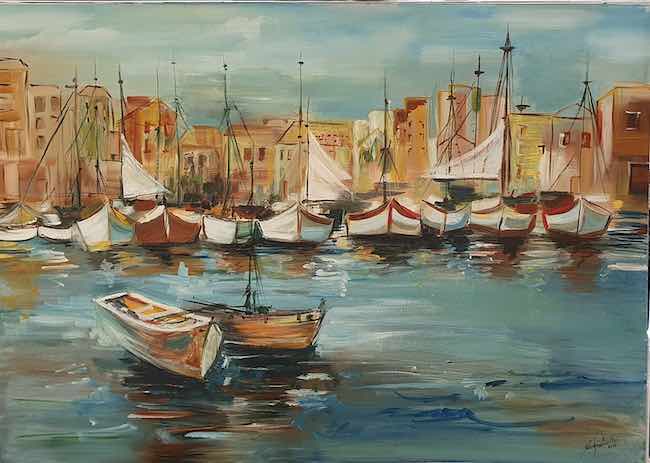Riuscire a cogliere i dettagli, i frammenti di ciò che appartiene all’esperienza quotidiana richiede la capacità di scomporre a volte gli accadimenti e gli eventi, per poi ricostruirli in quel percorso di introspezione, di rievocazione e di connessione con l’emotività che diventa funzionale a prendere atto delle sensazioni che il loro succedere ha suscitato; alcuni artisti manifestano il bisogno di distaccarsi completamente da tutto ciò che è reale per galleggiare all’interno di un ricco mondo emozionale che deve sfuggire a qualsiasi definizione, altri invece necessitano di soffermarsi e aggrapparsi proprio a quella realtà per esplorarne in maniera analitica ogni minimo dettaglio o di trascenderla avventurandosi in un mondo diverso fatto di incognite e di ignoto, e infine ci sono quelli che sentono la necessità di dare una descrizione frazionata per introdurre nell’opera tutta quella girandola di emozioni che solo accostate le une alle altre riescono a dare il reale senso di ciò che è stato vissuto. L’artista di cui vi racconterò oggi appartiene a quest’ultimo gruppo di creativi.
La fine del Diciannovesimo secolo fu contraddistinta da una sorta di ribellione stilistica agli schemi che in precedenza avevano dominato la scena artistica internazionale, perché i percorsi esistenziali stavano cambiando, la vita e il sentire dell’essere umano stavano diventando predominanti rispetto alla ricerca della forma e della bellezza appartenenti agli ambienti culturali dei secoli precedenti. Già alcuni movimenti di inizio Ottocento erano stati precursori di un desiderio di oltrepassare il confine estetico per tendere verso un approfondimento in cui l’interazione dell’artista con la tela potesse conquistare l’osservatore facendone vibrare le corde emotive; il Romanticismo Inglese con William Turner induceva l’uomo a riflettere sulla forza e la potenza della natura, lasciando fuoriuscire la riverenza e il senso di esiguità dell’individuo alla vista di tanta maestosità. Più avanti, intorno al 1866, si delinearono le linee guida del Simbolismo che si proponeva di studiare e analizzare la connessione tra essere umano e ambiente esterno attraverso però tutto ciò che non poteva essere osservato dallo sguardo, quelle energie sottili nascoste oltre le cose che costituivano un mistero da esplorare. Ma le modifiche più sostanziali e di distacco dalla figurazione tradizionale si concretizzarono attraverso due correnti pittoriche nate tra l’ultimo ventennio del Diciannovesimo e gli inizi del Ventesimo secolo, le quali per ragioni diverse introdussero un modo inedito di interpretare e raccontare la realtà osservata attraverso l’arte. L’Impressionismo ebbe un approccio analitico, quasi più scientifico poiché intendeva rappresentare tutto ciò che lo sguardo era in grado di cogliere con una tecnica innovativa in cui le pennellate erano brevi e frastagliate, accostando contiguamente tonalità che infondessero alla composizione luminosità e aderenza alla realtà, osservabile nella sua totalità allontanandosi dalla tela, ed escludendo il disegno meno adatto alla realizzazione rapida e en plein air che fu una caratteristica degli artisti che aderirono al movimento. E poi l’Espressionismo che volle mettere in primo piano il mondo interiore e l’emotività del soggetto ritratto a discapito dell’armonia estetica, sovvertendo regole di prospettiva, chiaroscuro, profondità ed estetica.
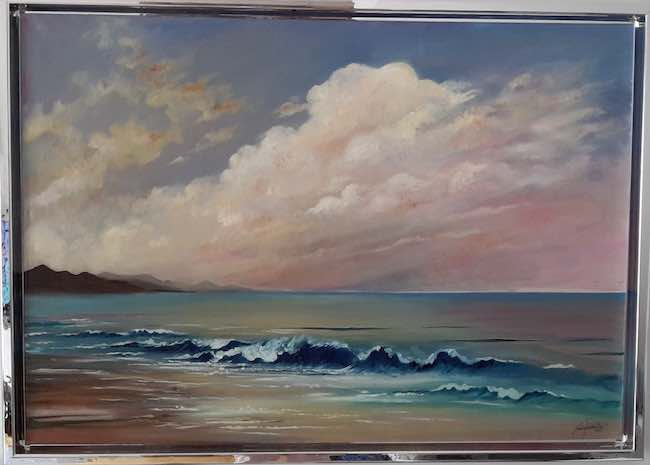
L’artista altoatesina Laura Pantarotto unisce nel suo linguaggio pittorico le linee guida dell’Espressionismo e dell’Impressionismo, il primo poiché per lei il cammino artistico rappresenta una presa di coscienza delle sensazioni che solo attraverso la manifestazione espressiva riescono a incontrare la consapevolezza che si trasforma in equilibrio, in serenità nell’accettazione di quel sentire intenso; il secondo invece subentra dal punto di vista formale nel momento in cui la frammentazione della pennellata è fondamentale non solo per lasciar interagire i colori permettendo attraverso il loro accostamento di cogliere e riprodurre le sfumature cromatiche, la luce e l’ombra dell’osservato, ma anche dal punto di vista emotivo poiché spesso la realtà, il ricordo, la rievocazione non possono essere narrati attraverso un punto di vista chiaro e univoco bensì hanno bisogno di fuoriuscire nel loro aspetto più prismatico, più scomposto per poi raggiungere la consapevolezza e concretizzarsi.
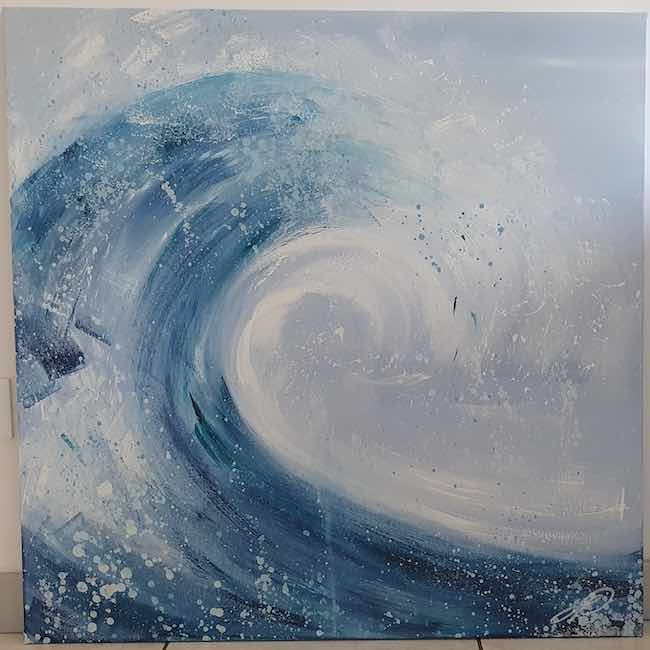
Il mondo emozionale della Pantarotto è poetico, armonico, tutte le sue opere evocano un senso di calma, di serenità, di equilibrio interiore che permette all’artista, tanto quanto all’osservatore, di entrare in profonda connessione con l’ambiente circostante, quella natura che diviene mezzo per perdersi e poi ritrovarsi in un universo interiore spesso lasciato in disparte davanti all’urgenza della quotidianità.
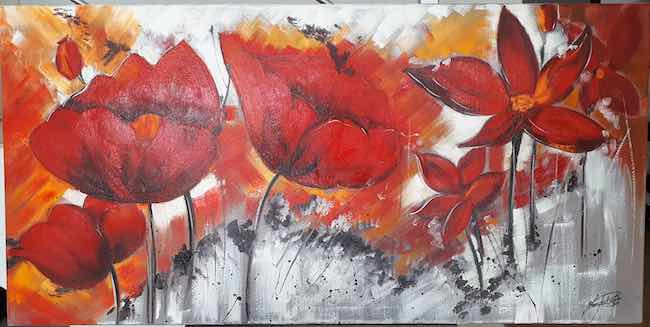
Sembra essenzialmente divisa in due la produzione pittorica di Laura Pantarotto, da un lato l’amore per il mare e per le barche, lei donna di montagna che troppo poco riesce a entrare in contatto con panorami tanto sconfinati e mobili, dall’altro invece l’osservazione e la simbologia dei fiori, quella delicata manifestazione della natura che ricorda all’essere umano l’alternarsi delle stagioni così come il dono dei colori, capaci con la loro semplicità di modificare l’aspetto di tutto ciò che ruota loro intorno, di ravvivare gli interni di una casa e di un giardino infondendo pace e felicità a chi sa osservarli con la giusta sensibilità.
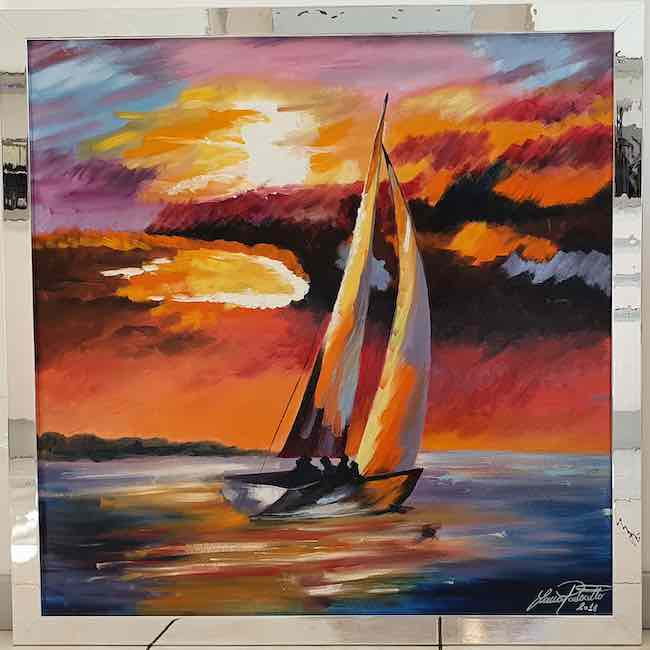
Nella tela A vele spiegate verso l’orizzonte emerge non solo l’amore della Pantarotto per un luogo magico dove il suo sguardo si è posato, sospeso tra cielo e acqua, ma anche quella sensazione di libertà che il mare suscita, quell’apertura verso possibilità e cambiamenti che si possono concretizzare grazie al suo perpetuo fluire, al suo scorrere verso l’inconosciuto; la gamma cromatica dell’opera racconta di un tramonto in cui però i colori sono più affini all’emozione percepita dall’artista che non alla realtà osservata, perché in fondo ciò che resta scolpito nella memoria è tutto ciò che viene percepito a livello profondo piuttosto che ciò che viene guardato con gli occhi. La barca a vela è metafora di quel sogno di libertà, quella capacità di alcuni di essere in grado di seguire il proprio flusso interiore lasciandosi andare alle modificazioni, ai cambiamenti, alle scelte necessarie per la ricerca della propria felicità.
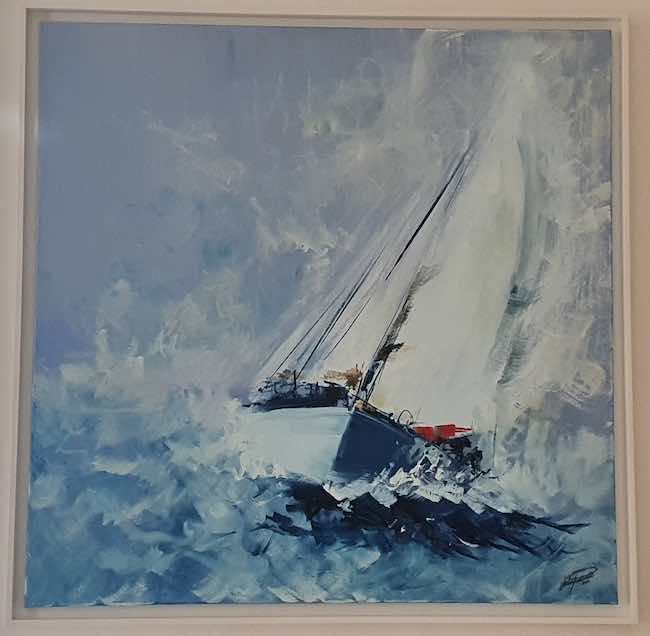
In Sopra le onde invece esplora un altro aspetto di quella libertà, le difficoltà che spesso devono essere affrontate per forgiare il carattere, per diventare consapevoli della propria forza, per scolpire e costruirsi ostacolo dopo ostacolo il futuro verso cui si è scelto di incamminarsi. Le tonalità di questo dipinto sono più realistiche, più attinenti al paesaggio descritto perché la parte emozionale è pienamente rappresentata dal colore steso in modo frastagliato, attraverso l’utilizzo della spatola, e dunque perfettamente affine al momento saliente della lotta dell’uomo con la natura, allegoria delle difficoltà che sopraggiungono nel momento in cui si prende la decisione di rischiare. Tuttavia, sembra suggerire la Pantarotto, malgrado la tempesta, la forza sta nella resilienza, in quel piegarsi della barca pur restando diritta, senza rovesciarsi, suggerendo che proprio oltre lo scoraggiamento e la paura di non farcela si trova l’impensata vittoria, la conferma che quel cammino impervio era quello giusto. Quando si dedica all’osservazione della flora l’artista diventa più poetica, più romantica nel manifestare tutta la magia che dai fiori si sprigiona, la delicatezza unita alla vivacità e alla forza di emergere dal terreno e mostrarsi in tutta la loro bellezza.
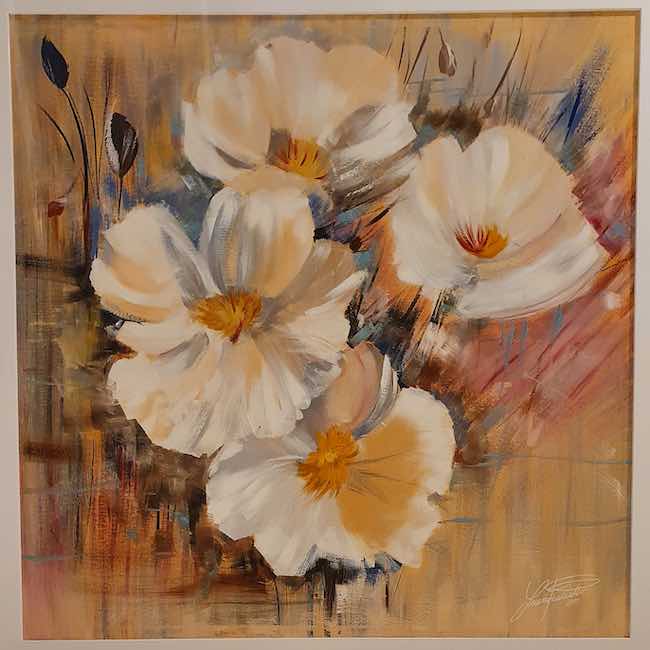
Nella tela L’essenza della primavera affida al bianco e all’ocra tenue il compito di conquistare l’osservatore con tutta la delicatezza, l’armonia, la vitalità trascinandolo all’interno di un mondo morbido ma vivace, essenziale per indurlo a ritrovare un contatto con se stesso, con la sua capacità di lasciarsi andare alla bellezza pura della natura che lo circonda. Perché per Laura Pantarotto la vita è colore, non si può rimanere all’interno del grigio, è necessario recuperare il contatto con tutto quel groviglio di tonalità che identificano la moltitudine di emozioni e che rendono la vita un’esperienza stimolante e sorprendente.
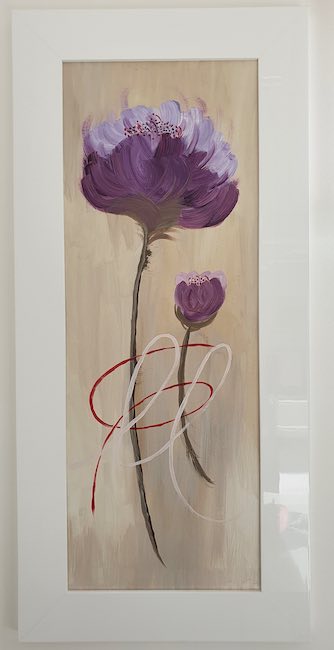
Non è necessario gridare per farsi ascoltare, sembra dire l’artista quando ritrae i suoi metafisici e sfaccettati fiori, perché l’armonia e l’equilibrio possono emergere solo attraverso il silenzio, tramite un approccio contemplativo e riverente nei confronti di tutto ciò che è circonda l’essere umano. Laura Pantarotto, di formazione autodidatta e tornata alla pittura dopo un lungo periodo di distacco, ha attualmente all’attivo la partecipazione a molte mostre collettive in Italia ed è stata inserita nel Primo tour Biennale d’Europa, che la vedrà esporre a Barcellona, Parigi, Londra e Venezia.
LAURA PANTAROTTO-CONTATTI
Email: laura.pantarotto74@gmail.com
Facebook: https://www.facebook.com/laura.pantarotto.7
Instagram: https://www.instagram.com/lau_paint/
The fragmentation of colour to recompose emotions and sensations in contemporary Impressionism by Laura Pantarotto
Being able to grasp the details, the fragments of what belongs to everyday experience requires the ability to sometimes break down happenings and events, and then reconstruct them in that path of introspection, evocation and connection with emotionality that becomes functional in order to take note of the sensations that their occurrence has aroused; some artists manifest the need to detach themselves completely from all that is real in order to float within a rich emotional world that must elude any definition, while others need to pause and cling to that very reality in order to explore every detail of it analytically or to transcend it by venturing into a different world made up of uncertaintes and the unknown, and finally, there are those who feel the need to give a fractional description in order to introduce into the artwork all that whirlwind of emotions that only when juxtaposed with each other can give the real sense of what has been experienced. The artist I am going to tell you about today belongs to the latter group of creatives.
The end of the 19th century was marked by a kind of stylistic rebellion against the patterns that had previously dominated the international art scene, because existential paths were changing, human life and feeling were becoming predominant over the pursuit of form and beauty belonging to the cultural circles of previous centuries. Already some movements of the early 19th century had been precursors of a desire to go beyond the aesthetic boundary to tend towards a deepening in which the artist’s interaction with the canvas could conquer the observer by making his emotional chords vibrate; English Romanticism with William Turner induced man to reflect on the strength and power of nature, letting out the individual’s reverence and sense of exiguity at the sight of such majesty. Later, around 1866, were outlined the guidelines of Symbolism which aimed to study and analyse the connection between human beings and the external environment through, however, all that could not be observed by the eye, those subtle energies hidden beyond things that constituted a mystery to be explored. But the most substantial changes and detachment from traditional figuration came about through two pictorial currents born between the last two decades of the 19th and the beginning of the 20th century, which for different reasons introduced a new way of interpreting and narrating reality observed through art. Impressionism had an analytical, almost more scientific approach as it intended to represent everything the eye was able to grasp with an innovative technique in which the brushstrokes were short and jagged, juxtaposing tones that infused the composition with luminosity and adherence to reality, observable in its totality by moving away from the canvas, and excluding drawing, which was less suited to the rapid and en plein air realisation that was a characteristic of the artists who adhered to the movement. And then there was Expressionism, which wanted to foreground the inner world and emotionality of the portrayed subject at the expense of aesthetic harmony, subverting rules of perspective, chiaroscuro, depth and aesthetics.
The South Tyrolean artist Laura Pantarotto unites in her pictorial language the guidelines of Expressionism and Impressionism, the former because for her the artistic journey represents an awareness of sensations that only through expressive manifestation can meet the awareness that is transformed into balance, into serenity in the acceptance of that intense feeling; the second, on the other hand, takes over from a formal point of view when the fragmentation of the brushstroke is fundamental not only to let the colours to interact, allowing the chromatic nuances, the light and shadow of the observed to be grasped and reproduced through their combination, but also from an emotional point of view since reality, memory and evocation often cannot be narrated through a clear and univocal point of view but need to emerge in their more prismatic, more decomposed aspect in order to reach awareness and become concrete. Pantarotto’s emotional world is poetic, harmonious; all her artworks evoke a sense of calm, of serenity, of inner balance that allows the artist, as much as the observer, to enter into a profound connection with the surrounding environment, that nature that becomes a means of losing oneself and then finding back again in an inner universe often left out in the face of the urgency of everyday life. Laura Pantarotto’s pictorial production seems to be essentially divided in two: on the one hand, her love for the sea and boats, she a woman from the mountains who too little manages to come into contact with such boundless and mobile panoramas; on the other hand, the observation and symbolism of flowers, that delicate manifestation of nature that reminds human beings of the alternation of the seasons as well as the gift of colours, capable with their simplicity of modifying the appearance of everything that revolves around them, of enlivening the interior of a house and a garden by instilling peace and happiness in those who know how to observe them with the right sensitivity.
In the canvas Sails unfurled towards the horizon, what emerges is not only Pantarotto’s love for a magical place where her gaze rests, suspended between sky and water, but also that sensation of freedom that the sea arouses, that openness towards possibilities and changes that can be realised thanks to its perpetual flow, its slide towards the unknown; the painting’s chromatic range tells of a sunset in which, however, the colours are more akin to the emotion perceived by the artist than to the reality observed, because in the end what remains engraved in the memory is everything that is perceived at a deep level rather than what is looked at with the eyes. The sailboat is a metaphor for that dream of freedom, that ability of some people to be able to follow their inner flow by letting go of the modifications, the changes, the choices necessary for the pursuit of their own happiness. In Over the waves, on the other hand, he explores another aspect of that freedom, the difficulties that often have to be faced in order to forge character, to become aware of one’s strength, to sculpt and build obstacle after obstacle the future towards which one has chosen to set out. The tones in this painting are more realistic, more relevant to the described landscape because the emotional part is fully represented by the colour spread in a jagged manner, through the use of the palette knife, and therefore perfectly akin to the salient moment of man’s struggle with nature, an allegory of the difficulties that arise when the decision to take risks is taken. However, Pantarotto seems to suggest, despite the storm, the strength lies in the resilience, in that bending of the boat while remaining upright, without capsizing, suggesting that it is precisely beyond discouragement and the fear of not succeeding that one finds the unexpected victory, the confirmation that that impervious path was the right one. When she dedicates herself to observing the flora, the artist becomes more poetic, more romantic in manifesting all the magic that emanates from flowers, the delicacy combined with vivacity and the strength to emerge from the ground and show themselves in all their beauty.
In the canvas The essence of spring entrusts the task of conquering the observer with all the delicacy, harmony, vitality to white and soft ocher, dragging him into a soft but lively world, essential to induce him to find a contact with himself, with the his ability to let himself go to the pure beauty of the nature that surrounds him. Because for Laura Pantarotto life is colour, one cannot remain within the grey, it is necessary to regain contact with all that tangle of tones that identify the multitude of emotions and make life a stimulating and surprising experience. It is not necessary to shout in order to be heard, the artist seems to say when she portrays her metaphysical, multifaceted flowers, because harmony and balance can only emerge through silence, through a contemplative and reverent approach to everything that surrounds the human being. Laura Pantarotto, self-taught and returning to painting after a long period of detachment, has currently participated in many group exhibitions in Italy and has been included in the First European Biennial Tour, which will see her exhibit in Barcelona, Paris, London and Venice.


